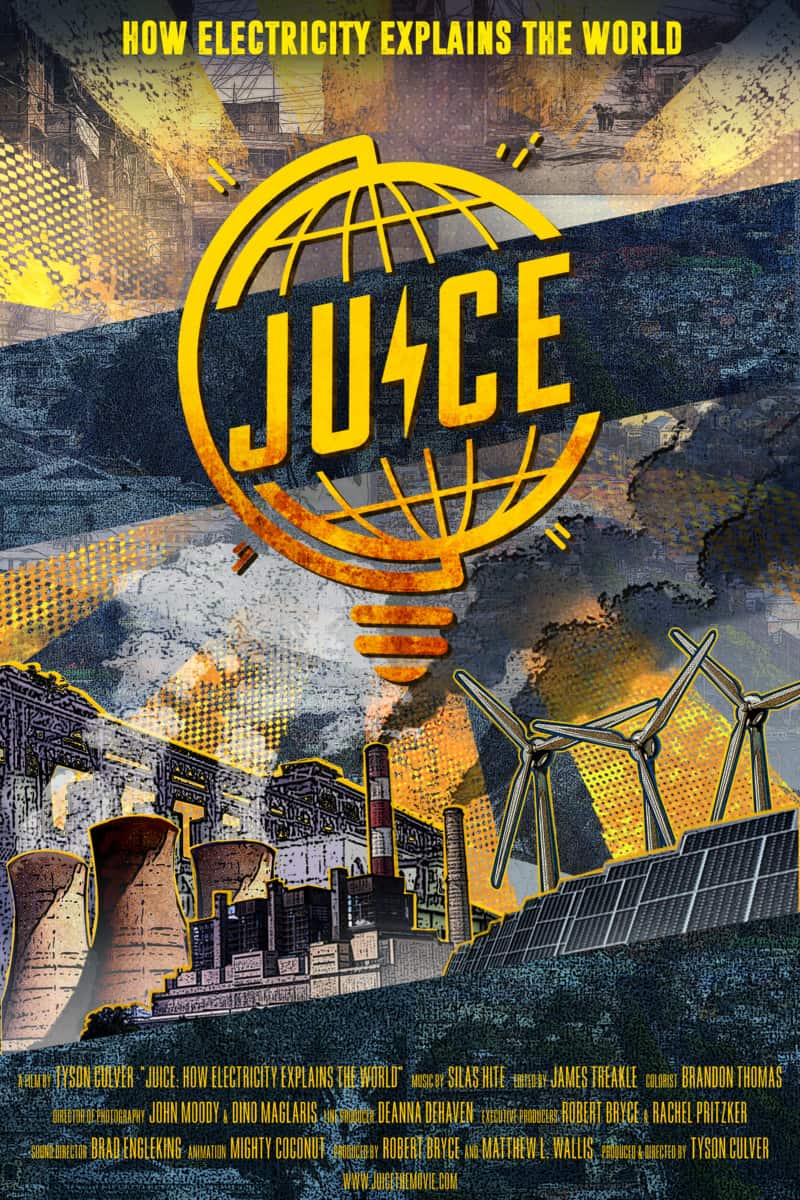Review: Juice: How Electricity Explains the World
It’s clear that Robert Bryce and Tyson Culver like living on a planet populated by humans.
They have produced a movie that celebrates electricity as the key enabler of the modern world that we have created. Their film challenges us to keep on building and improving our technology until everyone has abundant, reliable access to life-giving, life-enriching electrical power.
Juice: How Electricity Explains the World (Juice) serves as an almost perfect foil for Planet of the Humans (POTH), the far less optimistic, almost misanthropic film by Jeff Gibbs and Michael Moore.
Everyone deserves power
Not only does Juice take a positive view of humanity and its progress, but it does so in a way that addresses almost every objection raised by POTH’s sharpest critics. (See, for example this piece by Nader Sobhani from the Niskanen Center, this one on Vox by Leah Stokes, or this one by Eric Meyer from Generation Atomic.)
The subject matter is fresh, with almost every scene filmed within the past three years. In contrast, most scenes in POTH were in the can before 2013.

Juice’s faces and voices are diverse and geographically spread over the world. The crew traveled over 60,000 miles and filmed on locations in Lebanon, India, Puerto Rico, California, New York, Iceland, and Colorado. They spoke with women and men, academics and community leaders, engineers and activists.
Though they did not make it to Africa, they used illustrative archival footage and interviewed Priscilla Agyapong, a researcher from Ghana working for a the Center for Global Development. She makes it very clear that Africans, Indians and everyone else has a legitimate desire to have as much power as the typical American or European.
No one can legitimately accuse Robert Bryce of being a monotone narrator.
Here is how the filmmaker described his narrator.
Then there’s Robert. He wrote for the Austin Chronicle for a dozen years, one of the most liberal newspapers in the state of Texas. Later, he became a senior fellow at The Manhattan Institute, a conservative think tank in New York. He’s a bird watcher with solar panels on his roof – oh, and he lived with the Navajo for two years.
Bryce doesn’t fit in a box – he’s like a hippy pragmatist, always in search of the truth, who gets along with everyone. So we made him our tour guide, and the citizens of the world became the stars of the film.
Juice Director’s Statement
Sources of power
Juice portrays most current sources of electricity accurately, with both strengths and weaknesses revealed.

It credits Iceland’s abundant hydroelectricity and geothermal power for its cleanliness and contributions to moving the island economy from a fishing focus to one that attracts both aluminum smelting and cryptocurrency miners.
It highlights a resort in Lebanon that uses modern solar arrays and low cost, reliable batteries to operate independently from the country’s unreliable power grid and the “generator mafia” that deploys diesel generators to fill in the gaps when the grid goes down.
Robert visits a black market marijuana grower in Colorado who uses large quantities of electricity to grow his plants indoors and out of sight. Even though Colorado now has a legal marijuana market, the grower apparently started his indoor agriculture career a little too early. His criminal record keeps him out of the legal side of the market.
There is a great deal of attention paid to Puerto Rico’s post hurricane Maria blackout and the stresses caused by seven months without power.
Ecomodernist approach to technology
Juice’s creators and executive producers clearly embrace the ecomodernist approach to enabling people to thrive by spreading technological innovations and improvements. Jessica Lovering, Ben Heard, and Michael Shellenberger all have major speaking roles. The film crew took advantage of attendance at a Breakthrough Dialog event to capture several interviews.
The crew visits the Indian Point nuclear power plant. Bryce is clearly impressed with the spotless, compact installation and describes how it cleanly produces 25% of the electricity used by New York City.
Bryce and Culver were well aware that the plant was scheduled to close and that one of the units would be closed before they released their film. They used that knowledge and showed viewers scenes of the power plants that will provide the replacement power.
The film concludes with an “all of the above” message. But it’s clear that the film creators want the real path forward to be an effort to use the “best of the above” to make clean power cheaper and more readily available. Juice’s creators want everyone to be able to flip a switch and trust that power will be there to lighten their load.
Juice can be preordered on iTunes. After it is released there on June 2, it will be made available to order from a variety of other platforms. International releases are in the works. If you have any questions about obtaining the film, the creators are actively addressing them on Twitter @juiceforall.






This sounds a lot better than Moore’s doom-and-gloom piece. Can’t wait to watch it. Especially pleased that Shellenberger will be on. I was really impressed with his website and have used a bunch of his visuals for my nuclear FAQ (can be downloaded here)
Thanks for all the work you did.
It’s all possible with nuclear